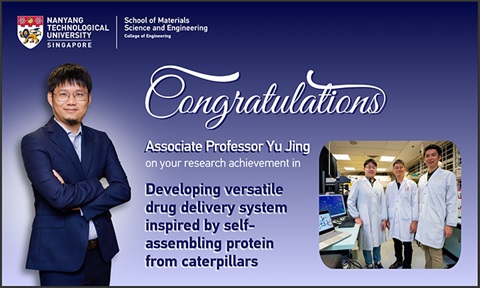A New Approach to Stabilise Perovskite Solar Cells Without Lead - Prof Lam Yeng Ming & Prof Sum Tze Chien (SPMS)
We are pleased to share that Professor Lam Yeng Ming and her team have been featured in the news for having discovered a way to manufacture non-toxic metal-based capping layers for perovskite solar cells.
The less environmentally damaging method involves replacing the traditional capping layer, which would result in the production of toxic lead when perovskites decompose or used for an extended time, with a zinc-based capping layer.
The researchers, led by Professor Sum Tze Chien (SPMS) and Professor Lam Yeng Ming (MSE), used the full precursor (FP) solution method to synthesise a capping layer that does not contain lead. Using the FP method, they coated the perovskites with solutions containing metal halide salts – compounds made of metal and elements that include chlorine, fluorine and iodine – and phenethylammonium iodide (PEAI) that is commonly applied to perovskites to improve the performance of perovskite solar cells. They found that a zinc-based compound PEA2ZnX4 synthesised using the method was the most effective capping material amongst the other materials tested. Unlike the typical approach of using the half precursor (HP) method to fabricate the capping layer, there is no need to draw lead ions up from the underlying perovskite layer to form this protective capping layer when the FP method is used, hence paving the way for the use of non-toxic metals in the capping layer.
The team’s fabricated solar cell was found to be as effective at converting sunlight to energy as conventional perovskite solar cells. In experiments with light that simulated sunlight, the solar cell could convert 24.1 percent of the light captured to electricity, close to the highest efficiency achieved by perovskite solar cells so far. Their prototype also demonstrated good reproducibility, with an average light conversion rate of almost 23 percent over 103 cells. It had a long lifespan, maintaining more than 90 percent of its ability to convert light into electricity for more than 1,000 hours of operation at full capacity.
Read more about the story on NTU Research Hub.
"As fossil fuels are depleting rapidly, we need to harness renewable energy resources such as solar energy much better. Eco-friendly and stable perovskite solar cells could be the answer and this innovation can potentially propel a wider scale adoption of perovskite solar cells for solar energy harvesting." - Professor Lam Yeng Ming - |
-v2.jpg?sfvrsn=71b312da_3)
A paper on this study was published in Nature Energy titled "Expanding the low-dimensional interface engineering toolbox for efficient perovskite solar cells".
Abstract
Three-dimensional/low-dimensional perovskite solar cells afford improved efficiency and stability. The design of low-dimensional capping materials is constrained to tuning the A-site organic cation, as Pb2+ and Sn2+ are the only options for the metal cation. Here we unlock access to a library of low-dimensional capping materials with metal cations beyond Pb2+/Sn2+ by processing a full precursor solution containing both metal and ammonium halides. This enables easier synthetic control of the low-dimensional capping layer and greater versatility for low-dimensional interface engineering. We demonstrate that a zero-dimensional zinc-based halogenometallate (PEA2ZnX4; PEA = phenethylammonium, X = Cl/I) induces more robust surface passivation and stronger n–N isotype three-dimensional/low-dimensional heterojunctions than its lead-based counterpart. We exhibit p–i–n solar cells with 24.1% efficiency (certified 23.25%). Our cells maintain 94.5% initial efficiency after >1,000 h of operation at the maximum power point. Our findings expand the material library for low-dimensional interface engineering and stabilization of highly efficient three-dimensional/low-dimensional perovskite solar cells.
About Nature Energy
Publishing monthly, Nature Energy is dedicated to exploring all aspects of this on-going discussion, from the generation and storage of energy, to its distribution and management, the needs and demands of the different actors, and the impacts that energy technologies and policies have on societies. We have a particular interest in studies that advance our knowledge and inform the development of next-generation technologies and solutions. Nature Energy provides a forum for all parties active at the frontiers of energy to come together and learn about the different facets of this sector. According to the Journal Citation Reports (Clarivate Analytics, 2022), the journal has a 2021 impact factor of 67.439.
Our heartiest congratulations to Prof Lam, Prof Sum and team on this excellent achievement!
Media coverage:
- NTU News
- The Engineer (UK)
- 21SPV.com (China)
- Solar.In (China)
- Sohu.com (China)
- News 7F
- List.Solar (US)
- Flipboard (US)
- Perovskite-info (Israel)
- Solar Magazine (China)
- Power Engineering International (UK)
- Nanowerk (US)
- PV Tech (US)
- Newsupdate.uk (India)
- News Azi (India)
- Tech Xplore (US) (visual story)
- Tech Xplore (US)






.tmb-listing.jpg?Culture=en&sfvrsn=3f725dd6_1)
